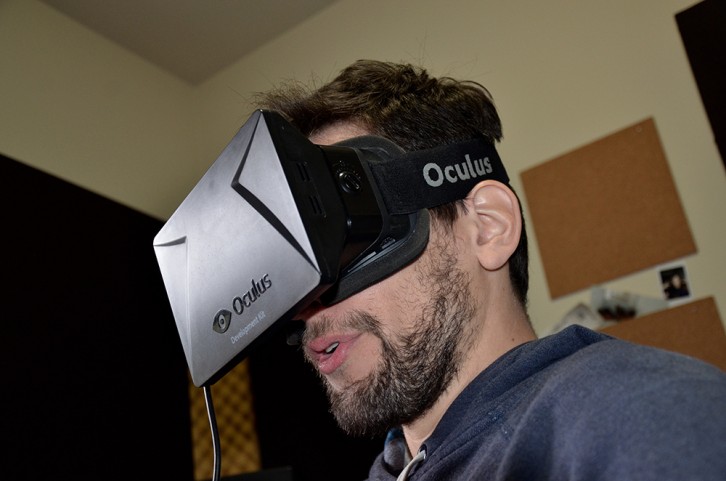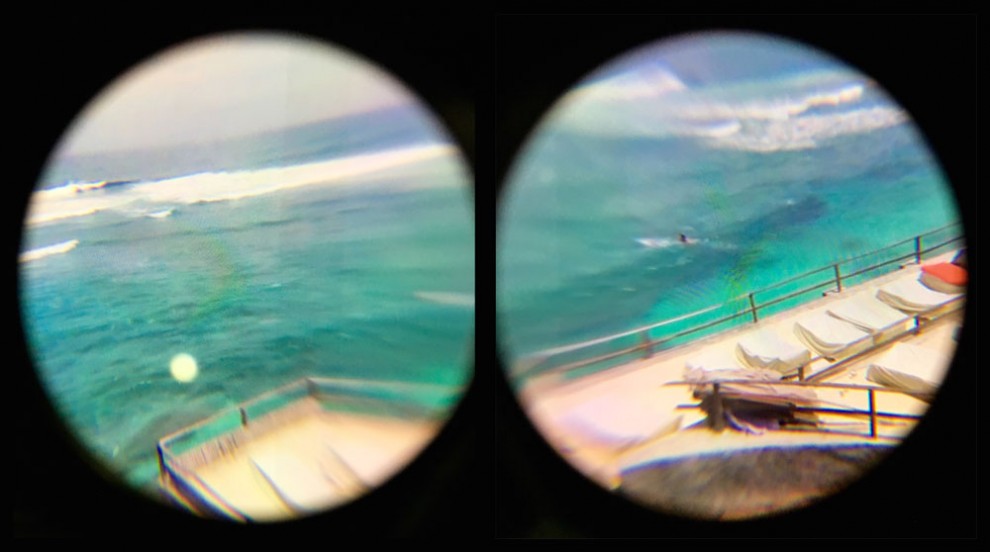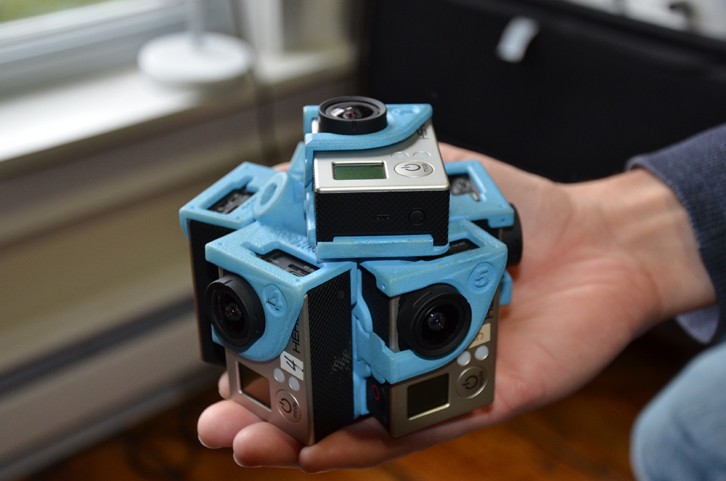Making virtual reality a reality

caption
Caption here.New technology offers a vivid way for journalists to tell stories
The first time Jamie Pallot experienced virtual reality was three years ago. The then-executive director at Vanity Fair was in Los Angeles for Vanity Fair’s Oscar Party when he decided to look up an old friend. At the time, Nonny de la Pena was running a virtual reality lab at the University of Southern California. De la Pena, the “godmother of virtual reality”, invited him to come take a look.
“It was this sort of aircraft hangar-sized space — you know, with a wall of servers along one end right out of a sci-fi movie,” Pallot said. “You put this sort of gigantic contraption on your head and suddenly you were somewhere else. You could walk around as if you were in a different scene, a different place.”

caption
The Oculus Rift Development Kit inspired other developers of virtual reality technology.Pallot was standing in a lab lined with motion-capture cameras to track his movements. Running from the server was a cable to Pallot’s headset, an apparatus consisting of a screen, headphones, wiring and some red-light-tipped crossbars. The machinery all worked together, allowing Pallot to move freely through a made-up digital environment, seeing it from any angle he desired. His mind was walking on a sunny street in Los Angeles while his body was physically walking around a lab.
Being somewhere you’re not
Virtual reality is the immersive experience that a person sees through a specialized viewer device. The viewing device projects an image onto a screen in front of the user’s eyes, tricking the brain into a false sense of presence at they look around the virtual space.
Dr. Daniel Pacheco, a digital journalist and professor at the University of Syracuse, says virtual reality is part of what he calls “experiential media”. Experiential media, according to Pacheco, creates full-body digital experiences. It removes the idea of “stories”, “readers” and “publishing” by allowing “readers” to become a part of the event itself.
Writing, filmmaking and radio allow for audiences to activate their senses when reading a story, virtual reality takes it a step further by placing the audience straight into the action.
“You can literally walk a mile in someone else’s shoes in virtual reality — that opens up all kinds of possibilities,” says Pacheco.
Virtual reality gives a chance for audiences to go places they might not be able to visit or see for themselves. Pacheco thinks this would be particularly good at communicating the stories of humans affected by war or disease. “If you could spend five minutes getting a sense, in virtual reality, of what’s really happening to those people — because you feel like you’re one of them for that short period of time — then you can relate to those kinds of stories that you hear later on, differently.”
Studies show that within virtual reality experiences are so immersive and stimulating that they can influence real-life behaviour and thought patterns.
The journalistic potential of virtual reality does not stop at its ability to deepen understanding within international reporting. Imagine watching the winning goal of the a sports game from the best seat of the house, or experiencing an ebola clinic from the inside. This is where journalism could go with virtual reality.
Keeping it real
Tom Kent, deputy managing editor and standards editor for the Associated Press, from his office in New York warns that journalists should devote a lot more attention to the “essential” editorial and ethical questions.
“(Virtual reality) is developing just so fast and it’s being developed by people who are not themselves (…) from the objective journalism tradition, ” Kent says. “I think they’re unaware of some of these ethical issues.”
These concerns, as well as others, are addressed in Kent’s ethical reality check for journalism. In the piece, Kent discusses the issues surrounding content advisories, accuracy, the role of reporters and other problems unique to virtual reality journalism.
In order to overcome the ethical obstacles facing virtual reality in its infancy, Kent suggests that journalists collaborate on solutions, be it in person or forums. Kent encourages those interested in virtual reality, when choosing subjects, to consider the use of content warnings and discretion.
Experience it yourself: The Samsung Gear VR
CNN decided to give live virtual reality broadcasting a try at the Oct. 13, 2015 Democratic presidential debate. Audiences were able to tune in to the debate’s live broadcast not just as television spectators, but as virtual guests.
People watching in virtual reality were able to capture the debate from four different camera angles that gave a sense of the Las Vegas auditorium’s space and atmosphere. Those tuning in on the virtual reality livestream could occupy the best seat in the house, staring straight at moderator Anderson Cooper and the candidates, without so much as getting off their couch at home.
People in 73 countries tuned in to the virtual reality livestream. The experience was met with mixed reviews.
Jason Abbruzzese, a business reporter at Mashable, gave up watching the broadcast after 45 minutes. Abbruzzese found the limitations of his viewing headset outweighed the benefits of the whole experience. He missed the social aspects of watching a debate: following his Twitter feed, chatting with people in the room. He wished there was an option to eat and drink. To make matters worse, his headset overheated.
“It is a really isolating experience,” said Abbruzzese. “At the end of the day, you are staring into a smartphone screen from very close — that can only really be so good.”
The technology for virtual reality is rough around the edges — the ethics are blurry, the headsets are awkward, distribution is a problem and most projects are still in the experimental phase. Despite virtual reality being in its infancy, Abbruzzese is “cautiously optimistic” about the medium.

caption
Left and right eye views of a beach from inside a Samsung Gear VR.CNN is not the only news organization to experiment with virtual reality in journalism. ABC News recently launched ABC News VR and the New York Times will be distributing more than one million virtual reality viewers.
2015 has been a year of advancements for virtual reality viewing devices (or “viewers”). For less than $20, anyone can buy a Google Cardboard, and for less than $100 the Samsung Gear VR. Big technology companies like Microsoft, HTC, Sony, GoPro and Canon are close to releasing similar technology.
With more and more headsets on the market, combined with the extra push from social media giants like Facebook, who purchased the virtual reality headset pioneer known as Oculus VR back in March 2015, journalists can expect to see an increase in production technology.
Taylor Owen, assistant professor of digital media and global affairs at the University of British Columbia, sounds a note of caution. “The problem is (…) ambitions are being driven by factors and technologies that aren’t necessarily connected to journalism in any real way,” says Owen. “We know this is good for gaming, and we know it is good for watching movies, but how, actually, is it useful for journalism?”
No play, no gain
“How does it apply to journalism?” is a question Robert Hernandez, a digital media professor for emerging topics at the University of Southern California’s Annenberg School for Journalism, spends his working life answering.
Since September, Hernandez and his students have been grappling with virtual reality’s application to the question in an unorthodox, “hackathon”-style class.

caption
A special camera rig is needed to capture panoramic live-motion video.“I try to take technology that is on the cusp of being injected into the mainstream and allow (…) my class to experiment with ‘what could journalism be on these platforms?’,” says Hernandez. “So if, and when, it hits mainstream, we’ve already answered some questions that a news organization new to the technology is trying to figure out.”
Hernandez, a self-described “mad scientist for journalism”, and his class, comprising of students from gaming, film, communications and journalism backgrounds, play with anything from the technical side of virtual reality to the narrative storytelling side. “There’s some (ethical and logistical) no-no’s in virtual reality, but we want to test them and go past them,” he says.
Hernandez’s career as a “veteran of web journalism” has taught him that new technology is always met with a fair share of push back.
“The industry always folds its arms (the pattern is that it folds its arms) and says ‘why should we invest in this technology? It’s not mainstream yet’,” says Hernandez. “It’s time to realize that it’s 2015 and we live in the future and technology is moving fast. If this hits, it will change everything again — more so than mobile.”
The most common complaints about this new technology, according to Hernandez, are equipment costs and the doubt that this will catch on with journalism audiences.
Ivan Lajara, life editor at the Daily Freeman newspaper in Kingston, N.Y. shares Hernandez’ enthusiasm but raises his own concerns about the technology’s implementation in smaller publications. “I cannot send or have any of my reporters spend a lot of time doing (virtual reality reporting) because we are very short-staffed,” Lajara says. “The easiest way possible, the better.”
New frontier
After his first brush with virtual reality three years ago, Jamie Pallot has become the co-founder of Emblematic Group, alongside CEO Nonny de la Pena. Pallot says his initial reaction to virtual reality reminded him of seeing the very first website in the early 1990s.
“(Virtual reality) is changing at the speed of light,” says Pallot, “… changing monthly, if not weekly, if not daily. It’s half of the challenge — staying on top of the best, newest, most effective, powerful and also most economical way of making stuff.”
As the virtual reality technology train races forward, the world of storytelling in journalism is due to reach a new frontier.
Cheap or DIY
VR viewers can be bought for as little as $20 (the Google Cardboard) or as much as $200. A viewer like this one is made out of simple materials: cardboard, lenses, tape and Velcro.
About the author

Linea Volkering
Honours Journalism/French major, Film Studies minor.
